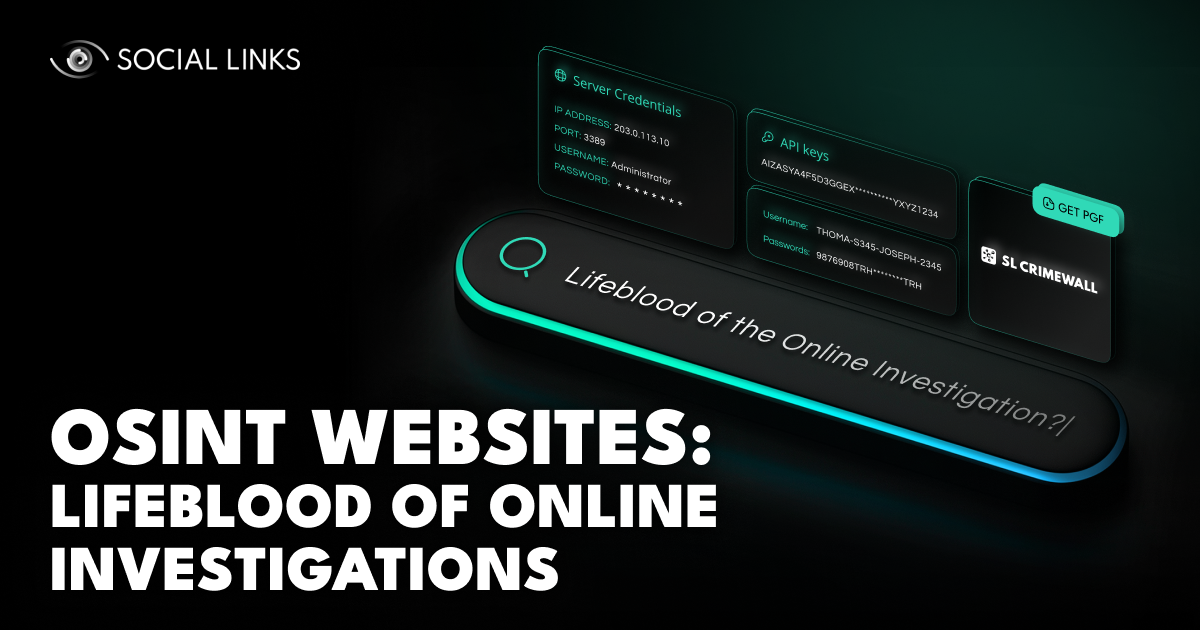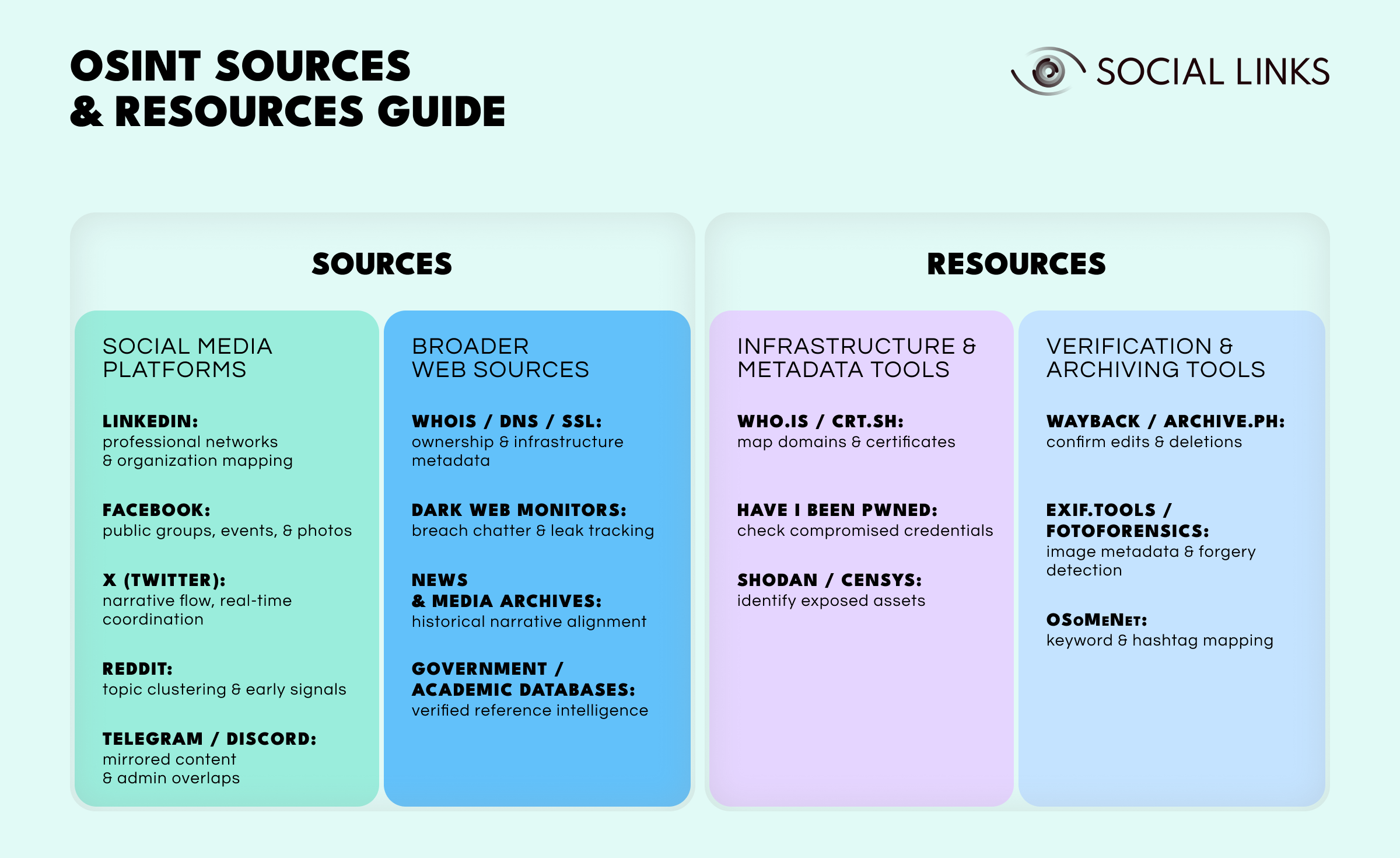OSINT Websites: Lifeblood of Online Investigations


Every investigation starts somewhere, and in open-source intelligence (OSINT), that somewhere is online. And the range of websites that an OSINT practitioner may use can be vast and varied, from social media posts and breach forums to WHOIS registries and archived pages. But correctly channeled, these sites can capture the digital footprint of people and organizations, and map online data trails. They often form the backbone of the investigation.
This article explores where OSINT data lives and how analysts turn it into usable intelligence. The first half focuses on OSINT sources, the platforms and registries where open data is found. The second looks at OSINT resources, the lookup, archive, and visualization tools that transform that data into something verifiable, searchable, and defensible.

OSINT sources fall into two main categories: the human layer (where behavior plays out in public), and the technical layer (where infrastructure quietly records it). Each provides unique entry points for identifying intent, context, and relationships across the web.
Social media remains the richest and most volatile environment for open-source intelligence. Every interaction—a like, a repost, a follow—tells part of a behavioral story. And different platforms reveal different dimensions of that story.
LinkedIn. With its corporate emphasis, LinkedIn is ideal for mapping professional networks and verifying affiliations. Job transitions, mutual connections, and organizational hierarchies help analysts identify insider overlap or lateral movement across institutions.
Facebook. The hugely popular social media archetype is great for understanding community dynamics and interpersonal networks. Public groups, event RSVPs, and shared images reveal how movements organize and interact, while friends, likes, comments, and tags are often critical components of a revealing digital footprint.
X (Twitter). Arguably the fastest reflection of real-time behavior, X is still a platform of great utility. Retweet networks, follower graphs, and quote chains help visualize how narratives spread and who the key brokers are connecting separate clusters.
Reddit. A platform that’s great as a structured forum for ideology and early signal detection. Subreddit metadata and posting patterns surface trends, vulnerabilities, or coordinated narrative testing before they reach mainstream visibility.
Telegram/Discord. These semi-private ecosystems can be extremely revealing because public content often mirrors or extends into restricted spaces. Analysts track admin overlaps, shared invite hashes, and bot behavior to map coordination networks.
Beyond social networks lies a deeper, more structured layer of OSINT: infrastructure, archives, and institutional records. These sources often verify or contextualize what’s seen in social feeds.
Domain data (WHOIS, SSL, DNS). These can provide registration details and highlight certificate reuse patterns. Shared registrant emails or SSL fingerprints often connect clusters of seemingly unrelated domains.
News and media archives. Context matters. Historical archives such as Archive.org and GDELT allow analysts to trace how stories evolve or resurface under new headlines.
Dark web monitors. Specialized crawlers can uncover breach data, credentials, or leak announcements. Used carefully, they expose threat actor chatter and data trade activity but users need to always be sure they are being deployed within legal and ethical bounds.
Academic and government databases. These sources can be overlooked but are often reliable. Public repositories like data.gov or Eurostat provide structured datasets for attribution, correlation, or statistical baselining.
Collecting data is only the start. OSINT resources such as lookup, archive, and visualization tools turn scattered traces into structured, verifiable intelligence. They connect discovery with confirmation and make analysis repeatable.
A solid place to start exploring these tools is osintframework.com, a well-known directory that maps out hundreds of open-source intelligence utilities. It doesn’t collect data itself but helps investigators quickly locate the right tool for the job—whether that means pivoting on a domain, tracing an email, or preserving a social media post before it disappears.
Below are some of the core categories and tools featured in that ecosystem—the ones most investigators rely on every day.
These tools reveal how digital assets connect below the surface. They expose relationships between domains, servers, and user identities—the technical truth behind online activity.
WHOIS / DNS / SSL Checkers. Platforms like who.is, SecurityTrails, and crt.sh make it possible to analyze domain ownership, DNS changes, and certificate reuse. Repeated SSL serials or common registrants often indicate shared infrastructure between phishing or control servers.
Have I Been Pwned. A standard in breach verification. Checking whether an email or domain appears in leaked datasets helps analysts confirm exposure and correlate accounts with threat activity.
Shodan / Censys. These are internet-wide scanners that catalog open assets, exposed ports, and service banners. They provide visibility into an organization’s external footprint or confirm the presence of compromised systems.
Online evidence is fragile. Posts vanish, domains expire, and media gets altered. Verification and archival tools anchor digital content in time, preserving authenticity and chain of custody.
Wayback Machine / Archive.ph. Archive snapshots of web pages and compare historical versions to detect deletions or narrative manipulation. They’re indispensable for confirming what existed and when.
Exif.tools / FotoForensics. By extracting image metadata and analyzing compression artifacts or edits, these tools help confirm whether an image was captured where and when it claims.
OSoMeNet (Observatory on Social Media Network). This is a research-driven toolkit for analyzing social graph propagation. It visualizes how narratives spread across multiple platforms, helping analysts identify coordinated amplification and bot clusters.
OSINT websites are the front door to open-source intelligence. They hold the raw data: posts, domains, documents, and behavioral traces. OSINT resources turn that data into intelligence—verified, contextualized, and ready to act on.
The best analysts aren’t collectors; they’re translators. They move between social signals and infrastructure records, linking behavior to systems and systems back to people. In the end, open-source intelligence isn’t about finding more information; it’s about finding the right information and proving it’s real.
Platforms like LinkedIn, X (Twitter), and Reddit remain essential for real-time open-source intelligence. They surface behavioral patterns, affiliations, and early signs of threat actor activity.
The most effective OSINT websites provide open, timestamped, and verifiable data. Reliability and continuity matter more than scale—every data point should trace back to its origin.
Start with WHOIS lookup tools, the Wayback Machine, and Have I Been Pwned. They verify domain history, preserve deleted content, and confirm data breaches—excellent starting points for foundational analysis.
OSINT sites host data; OSINT services analyze it. Services like domain aggregators or monitoring suites add enrichment, automation, and visualization on top of raw open-source material.
Through cross-verification—matching timestamps, metadata, and independent records from multiple unrelated OSINT sources before drawing conclusions.
Want to see how integrated OSINT platforms streamline the way you collect, verify, and visualize online data? Book a personalized demo with one of our specialists and explore how Crimewall unifies data discovery, infrastructure mapping, and social intelligence in a single investigative workspace.